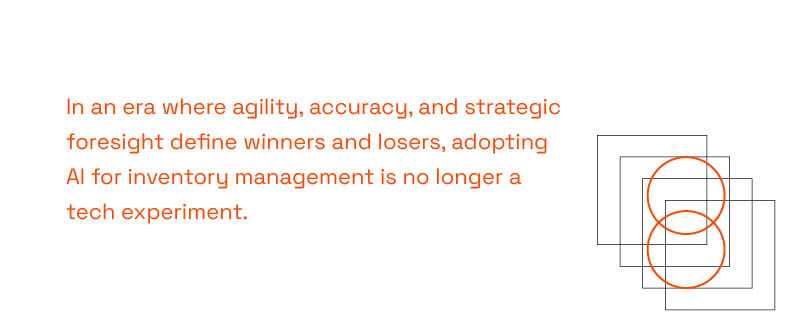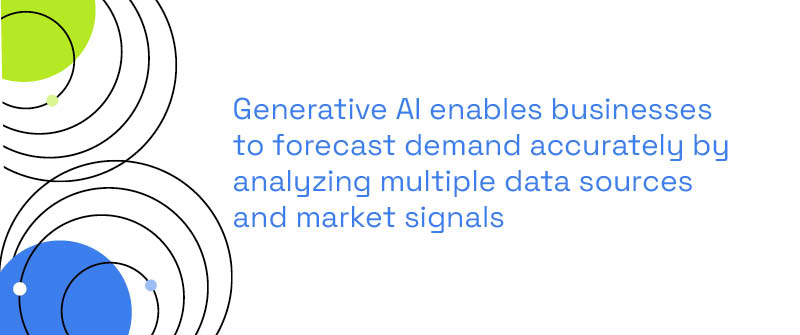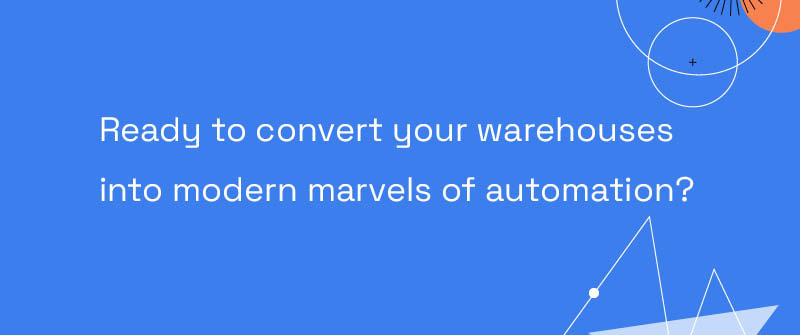
How Is AI Used in Inventory Management?
Artificial Intelligence (AI) is transforming inventory management from a traditional, reactive function into a dynamic, predictive discipline that directly supports strategic business goals. Rather than simply counting widgets and tracking when reorders are needed, modern AI-driven systems deliver near real-time predictive analytics, optimize stock levels, automate repetitive tasks, and empower leaders to make data-driven decisions with confidence and speed. These advancements are made even more powerful when combined with AI Data Management, which ensures that the underlying information feeding these systems is accurate, organized, and ready to drive smarter automation.
At its core, AI enables you to move beyond gut instinct and outdated spreadsheets. By leveraging AI inventory management software, you tap into continuous learning algorithms that analyze past sales, seasonal patterns, demand fluctuations, and even external signals (think weather forecasts or global supply chain events). These platforms predict demand before it happens, intelligently suggest reorder points, and suggest optimal replenishment strategies—sparing your business the costs and headaches of both overstocks and stockouts.
AI in Inventory Management: A Guide to Integrating AI-Driven Analytics and Power BI
One game-changer many leaders overlook is the synergy between AI-powered models and platforms like Power BI. When your AI inventory logic and dashboards live alongside your broader business intelligence suite, decision-makers no longer have to chase down scattered reports or squint at cryptic ERP exports. Instead, you get curated, visual insights delivered in real-time, complete with automated alerts, visual forecasts, and optional scenario modeling via embedded AI tools. AI-powered inventory systems enable real time inventory management and real time inventory tracking, providing instant stock visibility and updates across multiple locations, which reduces discrepancies and automates inventory processes.
And with Microsoft Fabric integration, this intelligence is woven seamlessly across your data ecosystem, so strategic decision-making happens at the speed of business. Advanced inventory systems leverage AI, IoT, and machine learning to automate and optimize stock management processes, further enhancing efficiency and accuracy.
The Strategic Value of AI for Inventory Processes
Adopting AI is more than just a cool move for your IT team—it’s a strategic business play that aligns daily operations with high-level business outcomes. For executives, integrating AI into inventory management means unlocking enterprise agility, improving forecast accuracy, and ensuring capital is deployed efficiently throughout the supply chain. Optimizing the inventory management process with AI directly contributes to business growth by improving efficiency, supporting expansion, and driving sustained competitive advantage. It means moving your business from reactively firefighting shortages or surpluses to proactively steering the ship with data-driven clarity.
P3 Adaptive’s resources, tailored for ambitious organizations, guide businesses like yours through this transformation. AI modernizes the inventory management process, making it more structured, efficient, and responsive to supply chain dynamics. Whether you’re curious about AI in inventory management case study examples or need hands-on help evolving legacy processes, our expertise ensures you not only implement AI—but actually extract ROI from it.
What’s the Payoff? ROI and Business Benefits
The proof is in the outcomes: companies leveraging AI-driven inventory management see measurable improvements in efficiency, accuracy, and supply-demand alignment. Cost savings aren’t limited to trimming excess inventory; they include freeing up working capital, minimizing lost sales due to stockouts, and dramatically reducing manual labor (and associated errors). AI-driven inventory management also plays a key role in enhancing customer satisfaction by ensuring product availability and efficient order fulfillment. And all of this is actionable—AI won’t just hand you a pretty chart, it will suggest optimizations, automate reorder workflows, and alert your team before issues become bottlenecks. AI provides valuable insights that help businesses make better inventory decisions and respond swiftly to market changes.
In an era where agility, accuracy, and strategic foresight define winners and losers, adopting AI for inventory management is no longer a tech experiment. It’s a board-level imperative—and the P3 Adaptive team is ready to help you claim your spot at the front of the innovation curve. Not sure where your organization stands? Hint: We know how to find out.

Generative AI and Predictive Analytics: The Next Frontier
Generative AI and predictive analytics are redefining what it means to manage inventory in a modern business environment. Where predictive analytics excels at interpreting historical data and forecasting demand trends, generative AI takes a bold step forward by creating new scenarios, simulating supply chain disruptions, and dynamically recommending adaptive strategies. Artificial intelligence is transforming supply chain operations by improving data management efficiency, resilience, and transparency across the entire supply chain. Integrating artificial intelligence into inventory management supports better decision-making and process optimization within supply chain operations. The combination of these technologies equips decision-makers with not just a view of what’s likely to happen, but a powerful toolkit for proactively designing supply strategies resilient to uncertainty.
What Is the Difference Between Predictive Analytics and Generative AI in Inventory Management?
Predictive analytics in inventory management focuses on examining past data—sales histories, seasonal cycles, and external variables—to predict future inventory requirements. Machine learning algorithms analyze historical sales data, market trends, and external factors to generate accurate demand forecasts. These demand forecasts are central to optimizing inventory levels and reducing stockouts. This traditional AI approach helps reduce overstock and stockouts by aligning procurement more closely with anticipated demand.
In contrast, generative AI actively creates new possibilities. It constructs simulations of complex supply chain disruptions, models “what-if” scenarios for demand shocks, and suggests innovative solutions that go beyond linear forecasting. Imagine running thousands of supply-and-demand scenarios overnight, with AI surfacing optimal inventory policies and highlighting risks your team might not have imagined. That’s the frontier business leaders can now reach.
Use Cases: Simulating Disruptions and Scenario Planning
The practical applications are transformative. Generative AI for inventory management empowers leaders to run stress tests: What if a primary supplier goes offline? How does a geopolitical event ripple through the supply chain? AI-driven scenario planning doesn’t just provide answers—it illuminates blind spots and enables truly dynamic response strategies. Generative AI supports inventory optimization within global supply chains by enabling businesses to adapt to disruptions and maintain efficient operations worldwide. This level of foresight enables inventory leaders to shift from being reactive crisis managers to proactive value generators.
Integration with Microsoft Fabric and Power BI: Unifying Data for Strategic Advantage
Of course, all the AI magic in the world is only as useful as your ability to operationalize and visualize it. This is where integrating AI models with Microsoft Fabric and robust BI dashboards in Power BI becomes a genuine game-changer. Fabric’s unified analytics layer pulls together disparate supply, sales, and logistics data, making it the perfect ecosystem for deploying generative models and predictive analytics. Advanced inventory management systems leverage data analysis to enable real-time tracking, demand forecasting, and automation across procurement, warehousing, and distribution. Integrating data analysis within inventory management systems improves accuracy and operational efficiency, ensuring better decision-making and optimized supply chain performance. Power BI provides the canvas on which insights leap off in real time, giving every executive a live view of shifting inventory landscapes and emerging risks—or opportunities.
How Can Businesses Start Leveraging Generative AI for Strategic Forecasting?
The best place to begin is by evaluating current inventory pain points. Are you chasing outdated data? Missing out on cost savings? The next step: collaborate with experts who understand both AI and your industry reality—think P3 Adaptive. With guided pilot programs, you can quickly connect your data to AI inventory management software, leverage the predictive muscle of Power BI, and start letting generative models raise the bar for scenario planning. Generative AI enables businesses to forecast demand accurately by analyzing multiple data sources and market signals, leading to more precise inventory decisions. The goal is actionable, defensible forecasts that stand up to real-world volatility—delivering ROI both in efficiency and in risk mitigation.
The bottom line is clear: If your supply chain still relies on spreadsheets, you’re running a marathon in flip-flops. Generative AI and predictive analytics are offering a real running shoe upgrade—elite performance that’s now within reach thanks to Microsoft Fabric, Power BI, and specialized consulting partners like P3 Adaptive. Looking ahead, future trends in AI technology will continue to reshape inventory management practices and strategies, driving further innovation and efficiency. The future of inventory management is learnable, implementable, and—when you take the first step—transformative.

How to Use AI Vision and Drones for Inventory Management?
AI vision and drones are redefining the art (and science) of inventory management from the ground up—or, more accurately, from the air down. By combining advanced computer vision algorithms with automated drones, today’s business leaders are achieving real-time, near-effortless verification of warehouse stock, slashing manual labor and error rates while boosting real operational agility. AI vision and drones are transforming warehouse management by automating the tracking and categorization of inventory items in real time, providing enhanced visibility and control over warehouse operations. As companies look to do more with less (without sacrificing data quality or their teams’ sanity), these technologies move from experimental to essential.
What is AI Vision and How Does It Automate Inventory Tracking?
AI vision uses machine learning to interpret visual data from cameras—think of it as giving your inventory system a pair of very sharp eyes and a well-trained memory. Mounted strategically in warehouses, these vision systems automate counting, detect misplaced items, and even spot damaged inventory, all with relentless accuracy and 24/7 stamina. AI powered inventory systems streamline inventory management processes by automating counting, tracking, and reporting tasks, reducing manual effort and minimizing errors. When paired with an AI inventory management app, organizations can act on insights instantly, routing alerts to managers and updating systems automatically. The automation payoff? Fewer missed counts, tighter inventory control, and an end to the “ask the night shift what happened” routine.
How Are Drones Used for Real-Time Warehouse Audits and Inventory Validation?
Drones take the grunt work—endless aisles, counting boxes in hard-hat zones, and all manner of repetitive scanning—and handle it with technological flair. Outfitted with cameras and guided by AI, drones can autonomously fly warehouse routes, perform stock takes in minutes (not days), and upload visually validated inventory data directly into management platforms. This is real-time automation in action. Drones enable real time inventory management by providing instant stock updates and enhance warehouse operations through automated audits and stock validation. Besides accuracy, drones deliver a fresh ROI: reduced labor needs and the ability to validate inventory at any moment, not just during costly annual audits.
What Challenges and Costs Should You Consider?
Of course, nothing worth having comes entirely free (even with so-called Free AI inventory management apps, there’s setup, security, and integration). Robust data collection is essential for accurate inventory tracking and maintaining system integrity. Investment in drone hardware, compliant operational protocols, AI training, and camera infrastructure does have a price tag. Leaders must also consider regulatory compliance, data privacy concerns, and, crucially, getting buy-in from teams used to traditional methods. AI can also analyze supplier performance metrics, such as delivery times and quality, to optimize procurement and supplier selection. But done right—with focused pilots and an integrated approach—ROI can be measured not only in hours saved but in improved service levels and reduced shrinkage.
Implementation Tips and What to Consider Before Going Airborne
Before sending those drones skyward, get strategic: define your baseline inventory areas, understand your workforce’s pain points, and involve IT in vetting solutions for security and data integration. Not all warehouses are created equal—physical layout, Wi-Fi coverage, and lighting all affect AI vision success. Ensure that your AI inventory management app can integrate data feeds from drones and cameras into your existing BI and ERP solutions—ideally, platforms that play well with Microsoft Fabric and Power BI, paving the way for seamless advanced analytics later on. It’s also crucial to integrate AI solutions with existing inventory management systems to maintain data accuracy and streamline operational workflows, especially when dealing with legacy systems. Additionally, AI can analyze supplier performance metrics such as delivery times, quality, and pricing, helping you improve supplier relationships and make better decisions. And don’t make it a science experiment—partner with consulting pros (like P3 Adaptive) to map your journey, sidestep the gotchas, and measure quick wins that scale.
Business Benefits: Why Modern Inventory Automation Isn’t Optional Anymore
The payoff? Think fewer manual errors, radically faster audits, and an empowered workforce freed up for higher-value tasks. Drones and AI vision break the old cycle of chasing lost inventory and firefighting missed shipments. For executives, the strategic gain lies in data-driven agility: faster, more reliable information drives sharper decisions and gives you a competitive edge in an economy where margin for error is razor-thin. Efficient inventory management enabled by AI not only reduces operational costs and waste but also supports business growth by improving scalability and positioning your company for long-term success.
Ready to convert your warehouses into modern marvels of automation? Whether you’re exploring DIY or deploying at scale, a conversation with the right experts may just save your bottom line—and your sanity. That’s what smart transformation looks like. (And yes, our team at P3 Adaptive loves helping leaders make it happen.)

How Can AI Optimize Inventory Management and Prevent Stockouts?
AI in inventory management is a true game-changer when it comes to preventing the high costs and reputational fallout of stockouts. By leveraging real-time data, intelligent analytics, and automated workflows from cutting-edge solutions like AI inventory management software and Power BI, business leaders gain the upper hand in predicting demand spikes, optimizing reorder points, and ensuring products are always available when customers need them. AI-driven demand forecasting enables businesses to maintain optimal inventory levels and optimize stock levels by accurately predicting future demand, helping to prevent both stockouts and overstocking.
The result is a smoother supply chain, fewer costly manual errors, and continuous availability—without bloated safety stocks quietly eating your margins.
Understanding Stockouts: The Business Impact and Reputation at Stake
Stockouts aren’t just an operational hiccup; they ripple across the organization—disrupting sales, souring customer loyalty, and sending finance teams scrambling to explain lost revenue. Preventing stockouts with AI-driven inventory management not only reduces lost sales but also ensures product availability and accurate, timely deliveries, resulting in improved customer satisfaction and greater customer loyalty. According to external benchmarks, the direct costs of stockouts can reach up to 4% of annual sales for retailers alone.[1] For decision-makers, the message is clear: every stockout is a red flag signaling the need for smarter, data-driven inventory oversight.
How AI Forecasts Demand Spikes and Triggers Timely Purchases
AI is redefining traditional inventory management by using predictive analytics to learn from historical trends, seasonality, and even external variables like market shifts or supplier performance. With these insights, AI inventory management software can automatically flag looming risks—think: an unusually warm spring driving higher ice cream demand—and trigger timely purchase orders before shelves go bare. By analyzing sales data and identifying demand patterns, AI can predict future demand and automate inventory replenishment, ensuring optimal stock levels and reducing the risk of overstock or stockouts. The upside? No more guesswork, frantic last-minute buying, or missed sales opportunities due to empty bins.
The Role of Real-Time Dashboards like Power BI
Static spreadsheets are relics when compared to the dynamic power of Power BI dashboards. With up-to-the-minute visibility into stock levels, lead times, and fulfillment KPIs, leaders and teams can act fast and decisively. Imagine dashboards that not only monitor inventory in real time but also showcase predictive alerts, heatmaps for potential stockouts, and scenario modeling, all at your fingertips. Integrating Power BI (and even better, pairing it with Microsoft Fabric’s data lake strategy) means you’re not just seeing the present—you’re anticipating the future, giving every executive a live view of shifting inventory landscapes and emerging risks—or opportunities.
With real time inventory tracking, businesses gain accurate, immediate updates on stock levels, enabling automated processes that reduce inventory holding costs and support inventory optimization by balancing supply and demand more efficiently.
Moving from Spreadsheets to Intelligent Systems: The Subtle Nudge
We get it: change can be hard, especially for teams that have lovingly (or stubbornly) clung to spreadsheets for years. But here’s the thing—every leader who guides their teams to embrace AI-powered tools gains a competitive edge in agility and insight. At P3 Adaptive, we’ve seen a single dashboard—crafted with Power BI—turn inventory ‘firefighting’ into strategic, proactive collaboration virtually overnight. The trick? Start with one business-critical metric: show the value, then let the self-service culture catch fire.
By adopting AI systems and AI driven systems, organizations enable continuous monitoring, automation, and optimization of inventory management tasks, leading to greater efficiency and accuracy.
Choosing the Right Solution: Free vs. Enterprise AI Inventory Management Software
The market is swimming with free AI inventory management apps and freemium pilots. But while these are fantastic for proof-of-concept, most organizations with real complexity and scale need deeper integration and guardrails—think unified data strategy, robust security, audit trails, and seamless connectivity with Power BI and Microsoft Fabric. A consulting partner like P3 Adaptive can help you cut through the noise, pinpoint the features that matter, and architect a roadmap that doesn’t just tick boxes—it outsmarts the competition.
Selecting the right inventory management system is crucial for leveraging AI-driven solutions at scale. For best practices and implementation strategies, consult resources like “AI in Inventory Management: A Guide” to ensure your approach is both effective and future-proof.
What’s the ROI of AI-Optimized Inventory—And How Fast Can You Get There?
With the right AI inventory management software in play, clients often see excess inventory drop by as much as 20% while stockouts disappear into insignificance. Couple that with the impressive analytics muscle of Power BI, and you’re looking at decision velocity, lower carrying costs, and a supply chain your competitors envy. AI-driven solutions automate inventory replenishment and help optimize inventory levels by dynamically adjusting reorder points and quantities based on demand forecasts, ensuring timely restocking and minimizing both excess stock and stockouts. Interested in what a smarter inventory future could look like for your business? Let’s talk—P3 Adaptive is ready when you are.

Taking Action: Steps to Modernize Your Inventory with AI (and Why it Matters)
AI-driven inventory management is no longer a futuristic luxury—it’s a mission-critical strategy for organizations intent on leading in operational efficiency, customer experience, and bottom-line growth. Decision-makers who act now to incorporate AI-powered solutions find themselves ahead of disruptions, leveraging predictive insights and streamlined workflows to minimize waste, prevent stockouts, and improve cash flow. The shift to smart inventory management isn’t just an IT upgrade—it’s a business transformation that touches every facet of supply operations and strategic planning.
AI is transforming inventory management by optimizing inventory management practices, automating processes, and supporting supply chain optimization through advanced analytics and real-time data, resulting in greater efficiency and accuracy across the entire operation.
What are the practical steps to start with AI in inventory management?
Embarking on the AI journey begins with a candid assessment of your current inventory processes and data maturity. Most organizations discover their existing data is scattered, their processes are highly manual, and their reporting capabilities are built in legacy spreadsheets—leaving blind spots and reactionary decisions as the status quo. The first step? Audit your inventory data and touchpoints. Map where data is collected, stored, and missed. This enables you to pinpoint bottlenecks and inefficiencies best suited for automation or predictive analytics.
AI can streamline inventory management processes by integrating advanced analytics and automation, enabling more efficient managing inventory. By leveraging accurate demand forecasts generated through AI and machine learning, organizations can optimize stock levels, balance supply and demand, and make proactive decisions that enhance overall efficiency and reduce costs.
From there, initiate pilot projects using robust BI tools—Power BI and Microsoft Fabric are not just buzzwords, but platforms purpose-built for real-time visualization, dynamic reporting, and scalable analytics. Design a proof-of-concept with a specific business challenge in mind, such as reducing deadstock or forecasting seasonal demand. Early wins will build trust and momentum.
Partnering with Experts: Why Consulting Services Matter
Too many organizations stumble by treating AI as a technology play rather than a strategic evolution. Successful transformation requires not just tools, but seasoned guidance—a dedicated partner who bridges the gap between business objectives and technical know-how. This is where consulting expertise becomes invaluable. A partner like P3 Adaptive brings proven frameworks, agile methodologies, and an inside-out understanding of data-driven operations. The result? Accelerated adoption, faster time-to-value, and confidence in every strategic move.
Consulting partners also help organizations implement AI-driven systems for inventory management, ensuring scalability and operational efficiency.
Change Management: Bringing Stakeholders On Board
Even the most elegant AI inventory management software will flop without user adoption. Executive buy-in, clear communication, and ongoing training are the unsung heroes of transformation. Make change management a deliberate part of your initiative. Invite key stakeholders into the pilot phase, letting them see early value through familiar data, interactive dashboards, and improved decision-making. Tying project outcomes directly to business objectives—cost reductions, service improvements, revenue upside—makes the benefits tangible and rallying the organization much easier. Successful AI adoption in inventory management can also enhance customer satisfaction by improving product availability and service quality.
Why should decision-makers prioritize AI-driven inventory solutions now?
Waiting for the perfect technological moment is a losing strategy. As supply chains grow more volatile and competition leans heavily on data, the risks of inaction compound. AI-driven inventory allows leaders to proactively identify demand shifts, optimize stocking levels, and outmaneuver uncertainty—delivering significant ROI and strengthening business resilience. AI-driven inventory management empowers businesses to meet customer demand by leveraging real-time insights and predictive analytics to respond quickly to changing customer demands and accurately forecast future demand patterns. With every delay, the cost of legacy processes accrues: stockouts, lost sales, excess inventory, and operational drag.
Forward-thinking organizations don’t just adopt new tools; they redefine what’s possible by transforming data into a true business asset. AI inventory management is a linchpin in this evolution, providing the flexibility and intelligence needed to thrive—no matter what the market throws your way.
Ready to shift from reactive inventory headaches to strategic advantage? Join forces with P3 Adaptive and put our expertise to work for your business. We tailor end-to-end AI inventory management solutions that empower leaders like you to convert data chaos into clarity—unlocking agility, efficiency, and lasting growth, all while de-risking every step of the journey. The future favors the bold—let’s make sure you’re out in front, not caught chasing the pack.
Get in touch with a P3 team member